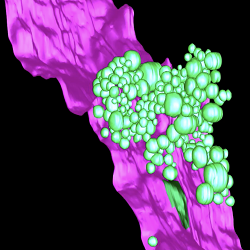
Prof. Gillian Griffiths’s lab studies cytotoxic T lymphocytes (CTLs) - serial killers which destroy multiple targets in succession. A new Science paper from the lab describes a unique mechanism for how CTLs perform this essential immune function.
Using high-resolution 3D imaging, Dr Jane Stinchcombe and colleagues show that T-cell receptor (TCR) activation causes rapid membrane specialization as diacylglycerol (DAG) is generated and accumulates across the immune synapse. DAG buds off into vesicles containing activated TCRs in a process known as “ectocytosis” that occurs exclusively across the synapse. As ectosomes bud off, CTLs and targets separate, allowing serial killing to proceed. This study shows that TCR-driven membrane specialization changes membrane function within the synapse, halting endocytosis and causing shedding of activated receptors. Thus, ectocytosis renders TCR signaling self-limiting.

